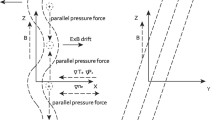Computational simulation of plasma diagnostics via microwave absorption has been successfully accomplished. This simulation capability is developed from solutions to a combination of the three-dimensional Maxwell equations and the generalized Ohm’s law in the time domain. As the simulation procedure developed, numerical results were obtained for a range of plasma transport properties including electrical conductivity, permittivity, and plasma frequency. The present results reveal the wave reflection at the media interface and substantial distortion of the electromagnetic field within a thin plasma sheet from a guided microwave. The present numerical simulation also accurately predicts the microwave blackout phenomenon as the wave propagates through a thick plasma sheet. The diffractions and refractions occurring at antenna apertures and passing through a plasma column are captured numerically. Finally, the numerical simulation has successfully duplicated a plasma diagnostic experiment in a hypersonic magneto-hydrodynamic channel.
Similar content being viewed by others
References
Shang J.S. (2002). Shared knowledge in computational fluid dynamics, electromagnetics, and magneto-aerodynamics. Prog. Aerospace Sci. 38(6–7): 449–467.
Roth J.R. (2000). Electrohydrodynamic flow control with a glow-discharge surface plasma. AIAA J. 38(7): 1166–1172.
Artana G., Adamo J., Leger L., Moreau E., Touchard G. (2002). Flow control with electrohydrodyamic actuators. AIAA J. 40(9): 1773–1779.
Enloe C.L., McLaughlin T.E., Van Dyken R.D., Kachner K.D., Jumper E.J., Corke T.J. (2004). Mechanisms and responses of a single dielectric barrier plasma actuator: plasma morphology. AIAA J. 42, 589–594.
Shang J.S., Surzhikov S.T. (2004). Magneto-aerodynamic interaction for hypersonic flow control. AIAA J. 43(8): 1633–1643.
Park C., Mehta U.B., Bogdanoff D.W. (2001). MHD Energy bypass scramjet performance with real gas effects. J. Propul. power 19(5): 1049–1057.
Miles R.B., Brown G.L., Lempert W.R., Yetter R., Williams G.L., Bogdonoff S.M., Natelson D., Guest J.R. (1995). Radiatively driven hypersonic wind tunnel. AIAA J. 33(8): 1463–1470.
Anikin, N., Kukaev, E., Starikovskaia, S., and Starikovskii, A. (2004). Ignition of hydrogen-air and methane-air mixtures at low temperatures by nanosecond high voltage discharge. AIAA 2004–0833, Reno NV, January 2004.
Heald M.A., Wharton C.B. (1965). Plasma Diagnostics with Microwaves. Wiley, New York.
Golant, V. E. (1983). Methods of diagnostics based on the interaction of electromagnetic radiation with a plasma, basic plasma physics I. In Galeev, A., and Sudan, R. (eds.), North Holland Publishing Co., Amsterdam, 630–680.
Raizer Yu., Gas P. (1991). Discharge Physics. Springer-Verlag, Berlin.
Smoot L.D., Underwood D.L. (1966). Prediction of microwave attenuation characteristics of rocket exhausts. J. Spacecraft Rockets 3(3): 302–309.
Fedrick R.A., Blevins J.A., Coleman H.W. (1995). Investigation of microwave attenuation measurements in a laboratory-scale motor plume. J. Spacecraft Rockets 32(5): 923–925.
Kurpik, A., Menart, J., Shang, J., Kimmel, R., and Hayes, J. (2003). Technique for making microwave absorption measurements in a thin plasma discharge. AIAA 2003–3748, Orlando, FL, 23–26 June 2003.
Shang J.S., Kimmel R., Hayes J., Tyler C., Menart J. (2005). Hypersonic magneto-aerodynamic experimental facility for magneto-aerodynamics interaction. J Spacecraft Rockets 42(1).
Kennet H., Taylor R.A. (1996). Earth re-entry simulation of planetary entry environment. J. Spacecraft Rockets 3(4): 504–512.
Krause J.D. (1953). Electromagnetics McGraw-Hill, pp.390–481.
Henderson, S., Menart, J., Shang, J. S., Kimmel, R., and Hayes, J. (2004). Data reduction analysis for a cylindrical, double langmuir probe operating in a high speed flow. AIAA 2004–0360, Reno NV, January 5–8, 2004.
Surzhikov S.T., Shang J.S. (2004). Two-Component plasma model for two-dimensional glow discharge in magnetic field. J. Comp. Phys. 1999, 437–464.
Lele S.K. (1992). Compact difference schemes with spectral-like resolution. J. Comp. Phys. 103, 16–42.
Carpenter M.H., Gottlieb D., Abarbanel S. (1995). Time-stable boundary conditions for finite-difference schemes solving hyperbolic systems: methodology and application to higher-order compact systems. J. Comp. Phys. 117, 300–317.
Shang J.S. (1999). High-order compact-difference schemes for time-dependent maxwell equations. J. Comput. Phys. 153, 312–333.
Gaitonde D.V., Shang J.S., Young J.L. (1999). Practical aspects of higher-order numerical schemes for wave propagation phenomena. Int. J. Numer. Methods Eng. 45, 1849–1869.
Taflove, A. (1997). Numerical issues regarding finite-difference time-domain modeling of microwave structures, time-domain methods for microwave structure analysis and design. In Itoh, T., and Houshmand, B. IEEE Press, New York, pp. 59–75.
Mur G. (1981). Absorbing boundary conditions for the finite-difference approximation of the time-domain electromagnetics field equations. IEEE Trans. Electromagn. Compatibility 23, 377–382.
Berenger J.-P. (1994). A perfect matched layer for the absorption of electromagnetic waves. J. Comp. Phys. 114, 185–200.
Shang J.S., Fithen R.M. (1996). A Comparative study of characteristic-based algorithms for the maxwell equations. Comput. Phys. 125, 378–394.
Shang J.S., Gaitonde D. (1995). Characteristic-based, time-dependent maxwell equation solver on a general curvilinear frame. AIAA J. 33(3): 491–498.
Shang, J. S. (2003). Computational electromagnetics for microwave attenuation in weakly ionized air. AIAA 2003–3621, Orlando, FL, 23–26.
Mitchner M., Kruger C.H., Jr. (1973). Partially Ionized Gases. Wiley, New York 126–241.
Gustafasson B. (1975). The Convergence rate for difference approximations to mixed initial boundary value problems. Math. Comp. 29, 396–414.
Balanis C.A. (1982). Antenna Theory: Analysis and Design. Wiley, NY, 8.3–8.86.
Maloney J., Smith, G., Thiele, E., and Gandhi, O. (2002). Modeling of antennas, computational electromagnetics: the-finite-difference, time-domain methods. In Taflove, A., and Hagnes, S. (Eds.), 2nd ed., Artech House, Boston, pp. 627–701.
Katz D., Piket-May M., Taflove A., Umashankar K. (1991). FDTD analysis of electromagnetic wave radiation from systems containing horn antennas. IEEE Tans. Antenna Propagation. 39(8):1203–1212.
Author information
Authors and Affiliations
Corresponding author
Rights and permissions
About this article
Cite this article
Shang, J.S. Simulating Plasma Microwave Diagnostics. J Sci Comput 28, 507–532 (2006). https://doi.org/10.1007/s10915-006-9092-x
Received:
Accepted:
Published:
Issue Date:
DOI: https://doi.org/10.1007/s10915-006-9092-x




